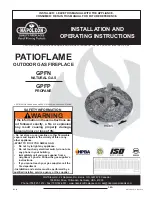
9
www.napoleongrills.com
WARNING!
If these instructions are not followed exactly, a fire causing death or serious injury may
occur.
Propane Cylinder Specifications
A dented or rusty cylinder may be hazardous and should be checked by your propane supplier. Never use a
cylinder with a damaged valve. Use only a propane supply cylinder constructed and marked in accordance with
the specifications for LP-gas cylinders of the National Standard of Canada, CAN/CSA-b339, Cylinders, Spheres
and Tubes for Transportation of Dangerous Goods; and Commission, as applicable or the Specifications for
LP-Gas Cylinders of the U.S. Department of Transportation (D.O.T.). This appliance has been designed for use
with a 20 lb. (9.1 kg)
or 30 lb (13.6 kg)
size propane cylinder only (not supplied).
The propane cylinder must be provided with a cylinder connection device compatible with the connection for
outdoor appliances.
The propane cylinder must be provided with a shut-off valve terminating in a propane
cylinder valve type QCC1, and a safety relief device having direct communication with the vapor space of the
cylinder. The cylinder supply system must be arranged for vapor withdrawal and the cylinder shall include a
collar to protect the cylinder valve. The cylinder shall incorporate a listed OPD (overfill protection device). Do
not store a spare LP-gas cylinder under or near this appliance. Never fill the cylinder beyond 80 percent full.
Use only the pressure regulator and hose assembly provided with this appliance. Replacement pressure
regulators and hose assemblies must be specified by the manufacturer. The regulator supplies a pressure of 11 inches. water
column to the appliance and has a QCC1 type fitting. Cylinders to be used with this unit must be supplied with
a QCC1 cylinder valve. A QCC1 cylinder has a positive seating connection, which will not allow gas flow until a
positive seal has been achieved. It is also equipped with an excess flow device. In order to attain full flow to
the appliance, the valve must be in the off position when the cylinder valve is turned on.
WARNING!
A fire will result if the gas supply hose makes contact with the underside of the appliance.
Gas Hook-Up Instructions
LP (Propane) Gas
Attach cylinder retaining bracket supplied to the base of the cylinder. Then secure to the surface to which it
sits. Cylinder should be on a level surface.
Cylinder Retaining Bracket
1. Fasten the bracket to the bottom of the propane bottle using bolt
and nut supplied.
2. Tighten the lag screw into the mounting surface leaving approximately
1/4” of thread above the surface.
3. Slide propane bottle into position so that the bracket slides under
the head of the lag screw.
4. Tighten the lag screw onto the bracket.
5. For fastening to a concrete surface a concrete anchor will be
required. (Not supplied)
Cylinder Connection
: Ensure the gas regulator hose is kink
free. Remove the cap or plug from the cylinder fuel valve.
Insert the black QCC1 regulator nipple onto the QCC1 fuel
valve. Hand tighten clockwise. Do not use tools. Leak test
all joints prior to using the appliance. A leak test must be
performed annually and each time a cylinder is hooked up
or if a part of the gas system is replaced.
If this appliance is to be connected directly to a house
propane gas supply line, follow the instructions for the
natural gas hook-up.
Summary of Contents for LINEAR PATIOFLAME GPFL48
Page 24: ...24 www napoleongrills com Parts Diagram...
Page 51: ...51 www napoleongrills com DIAGRAMME DE PI CES...
Page 52: ......










































